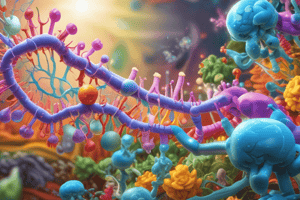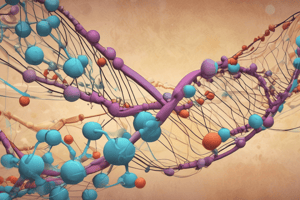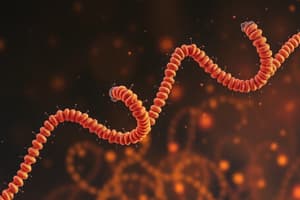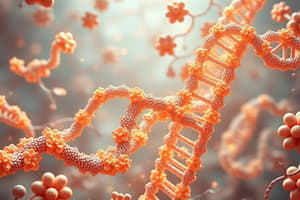Podcast
Questions and Answers
What is the role of tRNA in the translation process?
What is the role of tRNA in the translation process?
- To carry specific amino acids to the ribosome and match them with the mRNA codon. (correct)
- To deactivate mRNA, halting protein synthesis.
- To signal the release of the polypeptide chain from the ribosome upon reaching a stop codon.
- To form peptide bonds between amino acids within the ribosome.
During translation, the complementary base triplets on tRNA molecules are called ________, which pair with mRNA codons.
During translation, the complementary base triplets on tRNA molecules are called ________, which pair with mRNA codons.
anticodons
Which of the following is the correct sequence of events during translation?
Which of the following is the correct sequence of events during translation?
- mRNA attaches to ribosome → tRNA brings amino acids → polypeptide chain grows → completed polypeptide folds (correct)
- tRNA attaches to ribosome → mRNA brings amino acids → polypeptide chain grows → completed polypeptide folds
- Polypeptide chain grows → tRNA brings amino acids → mRNA attaches to ribosome → completed polypeptide folds
- Ribosome attaches to tRNA → mRNA brings amino acids → polypeptide chain grows → completed polypeptide folds
In translation, what signals the end of the polypeptide chain synthesis and triggers its release from the ribosome?
In translation, what signals the end of the polypeptide chain synthesis and triggers its release from the ribosome?
Match each DNA anticodon (template strand) with its corresponding mRNA codon, tRNA anticodon, and amino acid, based on standard base pairing rules:
Match each DNA anticodon (template strand) with its corresponding mRNA codon, tRNA anticodon, and amino acid, based on standard base pairing rules:
What role do 'stop' codons play in the synthesis of polypeptides?
What role do 'stop' codons play in the synthesis of polypeptides?
The sequence of amino acids in a polypeptide chain is determined by the genetic code encoded in transfer RNA (tRNA).
The sequence of amino acids in a polypeptide chain is determined by the genetic code encoded in transfer RNA (tRNA).
What is the primary function of transfer RNA (tRNA) in protein synthesis?
What is the primary function of transfer RNA (tRNA) in protein synthesis?
Ribosomes, which are essential for translation, are composed of ribosomal RNA (rRNA) and ______ molecules.
Ribosomes, which are essential for translation, are composed of ribosomal RNA (rRNA) and ______ molecules.
If a protein consists of 150 amino acids, how many nucleotides are minimally required in the mRNA that codes for this protein, excluding start and stop codons?
If a protein consists of 150 amino acids, how many nucleotides are minimally required in the mRNA that codes for this protein, excluding start and stop codons?
MicroRNA (miRNA) primarily regulates gene expression by directly altering the DNA sequence of specific genes.
MicroRNA (miRNA) primarily regulates gene expression by directly altering the DNA sequence of specific genes.
Match each type of RNA with its primary function in protein synthesis:
Match each type of RNA with its primary function in protein synthesis:
Which of the following characteristics is unique to mRNA, distinguishing it from other types of RNA?
Which of the following characteristics is unique to mRNA, distinguishing it from other types of RNA?
What is the primary function of miRNA in gene expression?
What is the primary function of miRNA in gene expression?
Exons are non-coding regions of DNA that are transcribed into pre-mRNA but do not code for proteins.
Exons are non-coding regions of DNA that are transcribed into pre-mRNA but do not code for proteins.
What process removes introns from pre-mRNA to ensure the correct sequence of amino acids is present for protein synthesis?
What process removes introns from pre-mRNA to ensure the correct sequence of amino acids is present for protein synthesis?
The coding DNA, known as _______, is transcribed into mRNA and then translated into a polypeptide or protein molecule.
The coding DNA, known as _______, is transcribed into mRNA and then translated into a polypeptide or protein molecule.
During transcription, which strand of DNA serves as the template for mRNA synthesis?
During transcription, which strand of DNA serves as the template for mRNA synthesis?
RNA splicing removes exons from the pre-mRNA molecule.
RNA splicing removes exons from the pre-mRNA molecule.
Match the type of RNA with its involvement in protein synthesis:
Match the type of RNA with its involvement in protein synthesis:
What enzyme is responsible for separating the DNA strands and binding RNA nucleotides during transcription?
What enzyme is responsible for separating the DNA strands and binding RNA nucleotides during transcription?
Which of the following is a primary difference between exons and introns?
Which of the following is a primary difference between exons and introns?
During translation, the start codon that initiates the process is ________.
During translation, the start codon that initiates the process is ________.
Transcription is the process where mRNA is translated into a protein.
Transcription is the process where mRNA is translated into a protein.
In which cellular compartment does transcription occur?
In which cellular compartment does transcription occur?
If miRNA's function of deactivating mRNA was inhibited, what would be the most likely outcome?
If miRNA's function of deactivating mRNA was inhibited, what would be the most likely outcome?
Which of the following is NOT a stop codon involved in the termination stage of translation?
Which of the following is NOT a stop codon involved in the termination stage of translation?
Match the following terms with their descriptions:
Match the following terms with their descriptions:
What is the direction in which ribosomes read mRNA during translation?
What is the direction in which ribosomes read mRNA during translation?
In eukaryotic cells, which of the following processes occurs exclusively in the nucleus?
In eukaryotic cells, which of the following processes occurs exclusively in the nucleus?
Introns are coding segments of DNA that are translated into a polypeptide chain.
Introns are coding segments of DNA that are translated into a polypeptide chain.
What is the role of tRNA in the process of translation?
What is the role of tRNA in the process of translation?
A gene is a unique sequence of ________ that codes for a functional protein or RNA molecule.
A gene is a unique sequence of ________ that codes for a functional protein or RNA molecule.
Match the following RNA types with their roles in protein synthesis:
Match the following RNA types with their roles in protein synthesis:
Which of the following is TRUE regarding the directionality of DNA strands?
Which of the following is TRUE regarding the directionality of DNA strands?
Given the template strand DNA sequence 3'-TAC-5', what is the corresponding mRNA codon?
Given the template strand DNA sequence 3'-TAC-5', what is the corresponding mRNA codon?
The term 'codon' predominantly refers to the triplets of bases along the DNA, which will synthesize the protein directly.
The term 'codon' predominantly refers to the triplets of bases along the DNA, which will synthesize the protein directly.
Flashcards
Gene
Gene
A unique sequence of nucleotides coding for proteins or RNA.
Protein Synthesis
Protein Synthesis
The process of transcribing mRNA from DNA and translating it to amino acids.
Exons vs Introns
Exons vs Introns
Exons are coding segments, Introns are non-coding segments of DNA.
Codon
Codon
Signup and view all the flashcards
Stop Codon
Stop Codon
Signup and view all the flashcards
mRNA
mRNA
Signup and view all the flashcards
Anticodon
Anticodon
Signup and view all the flashcards
5' to 3' Direction
5' to 3' Direction
Signup and view all the flashcards
Polypeptide
Polypeptide
Signup and view all the flashcards
Amino acids
Amino acids
Signup and view all the flashcards
Exons
Exons
Signup and view all the flashcards
Introns
Introns
Signup and view all the flashcards
RNA Splicing
RNA Splicing
Signup and view all the flashcards
Ribosomal RNA (rRNA)
Ribosomal RNA (rRNA)
Signup and view all the flashcards
Transfer RNA (tRNA)
Transfer RNA (tRNA)
Signup and view all the flashcards
Pre-mRNA
Pre-mRNA
Signup and view all the flashcards
Protein Function
Protein Function
Signup and view all the flashcards
Transcription
Transcription
Signup and view all the flashcards
RNA Polymerase
RNA Polymerase
Signup and view all the flashcards
Template Strand
Template Strand
Signup and view all the flashcards
Polypeptide Chain
Polypeptide Chain
Signup and view all the flashcards
Initiation Stage
Initiation Stage
Signup and view all the flashcards
Ribosome
Ribosome
Signup and view all the flashcards
tRNA Function
tRNA Function
Signup and view all the flashcards
Peptide Bond Formation
Peptide Bond Formation
Signup and view all the flashcards
Role of miRNA
Role of miRNA
Signup and view all the flashcards
Study Notes
RNA & Protein Synthesis
- A gene is a unique sequence of nucleotides that codes for a functional protein or RNA molecule.
- Protein synthesis involves two main steps: transcription and translation.
- In eukaryotic cells, transcription occurs in the nucleus, while translation happens at the ribosomes.
- The coding sequence (exons) on DNA are transcribed into messenger RNA (mRNA), which carries the genetic code to the ribosomes for protein synthesis. Non-coding sequences (introns) are removed.
- The mRNA is translated into a sequence of amino acids, which form a polypeptide chain, the building block of proteins.
- DNA codons, RNA codons, and anticodons determine the sequence of amino acids in proteins.
- DNA strands are directional (5' → 3') and the information is read in that direction during DNA replication and transcription into RNA.
- RNA is a single-stranded molecule made of nucleotides with ribose sugar and uracil instead of thymine.
- RNA Types:
- mRNA: carries the genetic code from DNA to ribosomes;
- tRNA: transports amino acids to ribosomes;
- rRNA: forms ribosomes, site of protein synthesis;
- miRNA: regulates gene expression after transcription.
- Codons are three-base sequences on mRNA that code for specific amino acids. There are 20 amino acids.
- Some codons are stop codons, signaling the end of protein synthesis.
- mRNA is synthesised using DNA as a template in transcription. This occurs in the nucleus of the cell and the mRNA undergoes modification before moving to the cytosol.
- tRNA has an anticodon, a three-base sequence complementary to a specific mRNA codon.
- tRNA carries a particular amino acid to the ribosome.
- Ribosomes are the sites of protein synthesis, made of rRNA and proteins.
Polypeptides
- Polypeptides are polymers of amino acids linked by peptide bonds.
- The sequence of amino acids in a polypeptide determines its three-dimensional structure and function.
- Proteins are made up of one or more polypeptide chains.
- The specific amino acid sequence is determined by the genetic code.
- Amino acids are the building blocks of proteins.
Exons and Introns
- DNA is divided into coding (exons) and non-coding (introns) regions.
- Exons are the parts of a gene that code for a protein.
- Introns are the non-coding regions within a gene.
- Introns are removed from the pre-mRNA before translation into a functional protein, this is called RNA splicing.
- The remaining exons are joined together to form the mature mRNA that codes the correct sequence of amino acids in the protein.
Transcription
- Transcription is the first step in gene expression and involves the synthesis of mRNA from a DNA template.
- RNA polymerase separates the DNA strand.
- Free RNA nucleotides bind to the DNA template strand, following complementary base pairing rules.
- RNA nucleotides are added to the 3' end of the DNA template strand, in the 5' → 3' direction.
- Pre-mRNA is processed by RNA splicing, removing introns to leave mature mRNA.
Translation
- Translation is the process where mRNA is used to synthesize a polypeptide chain of amino acids from a sequence of codons.
- mRNA attaches to the ribosome.
- tRNA molecules bring the specific amino acids to the ribosome based on their anticodons.
- Peptide bonds form between the amino acids as the ribosome moves along the mRNA.
- The process continues until a stop codon is reached.
- The polypeptide chain is released from the ribosome.
Studying That Suits You
Use AI to generate personalized quizzes and flashcards to suit your learning preferences.




